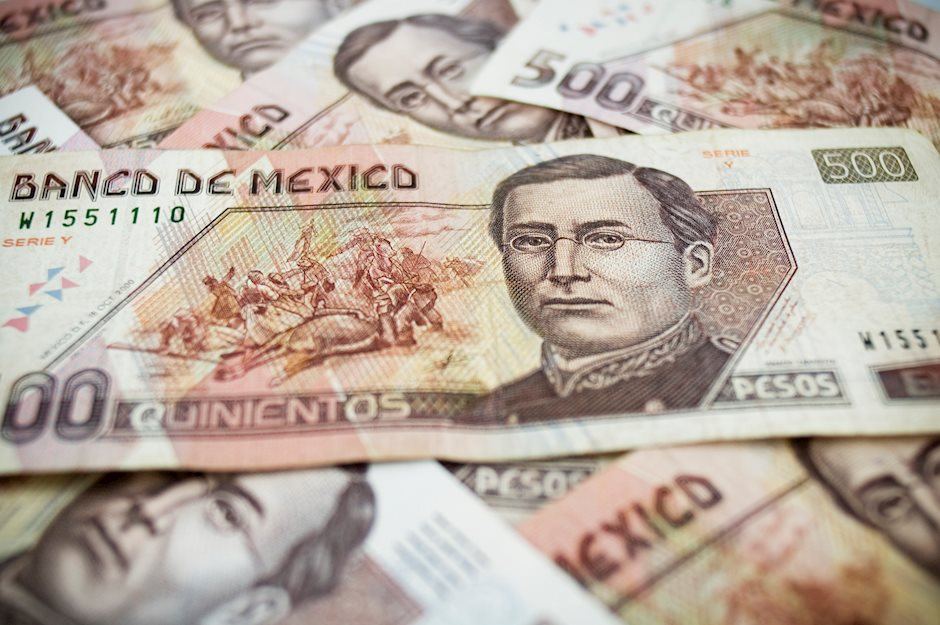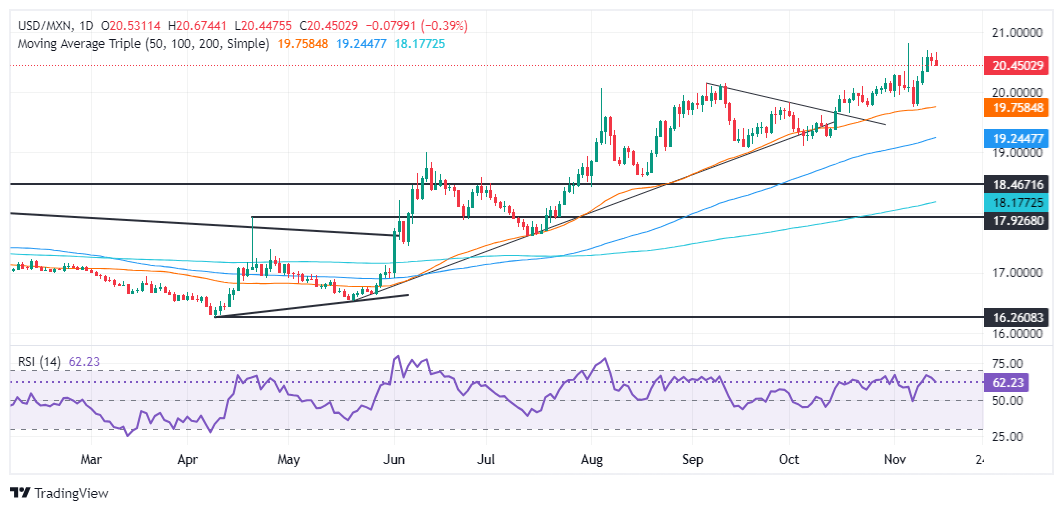Mexican Peso rallies late after Banxico's rate cut, US Retail Sales eyed
- Mexican Peso on the offensive, boosted by Banxico’s decision.
- Banxico reduces its key rate to 10.25%, citing progress in the disinflation process despite higher inflation risks.
- US inflation data hints at halted disinflation, potentially influencing Fed's future decisions.

The Mexican Peso appreciates against the US Dollar on Thursday after the Bank of Mexico (Banxico) decided to lower borrowing costs by 25 basis points. This overshadowed solid data from the US hinting that disinflation has halted. The USD/MXN trades at 20.44, down by 0.25%.
Banxico’s Governing Council voted unanimously to lower borrowing costs from 10.50% to 10.25%, as expected even though acknowledging that headline inflation risks are tilted to the upside.
On its monetary policy statement, Governors added that although inflation remains high, requiring a restrictive policy, they added that the disinflation process “implies that it's adequate to reduce the level of monetary policy restriction.” Officials expect inflation would converge to the 3% goal by the last quarter of 2025.
The US Bureau of Labor Statistics revealed that prices paid by producers topped estimates in core and headline figures. At the same time, the number of Americans filing for unemployment claims dipped below estimates and the previous week's reading for the week ending November 9.
In the meantime, the Federal Reserve (Fed) parade continued. Fed Governor Adriana Kugler stated the Fed must be mindful of both inflation and employment mandates. Later, Richmond Fed President Thomas Barkin said the US central bank has made progress on inflation, but needs to continue.
According to CME FedWatch Tool data, odds for a rate cut decreased from 82% a day ago to 78% on Thursday, post PPI data.
Ahead this week, Mexico’s economic docket will feature the Banxico policy decision. On the US front, Fed speakers and Retail Sales will help dictate the direction of the USD/MXN pair.
Daily digest market movers: Mexican Peso steadies against US Dollar
- The USD/MXN hovers around 20.50 ahead of Banxico’s decision.
- The US Dollar Index (DXY), which tracks the performance of the Greenback against six peers, holds to minimal gains of 0.08% at 106.56 after refreshing yearly highs of 107.06.
- The Producer Price Index (PPI) in the US exceeded estimates. Headline PPI rose by 2.4% YoY, exceeding forecasts of 2.3%, up from 1.9% in September. Core PPI, which usually impacts the calculation of the core Personal Consumption Expenditures (PCE) Price Index, expanded by 3.1%YoY, up from 2.9% and above projections of 3%.
- Initial Jobless Claims for the week ending November 9, were 217K, down from prior 221K a week earlier and below forecasts of 223K.
- Data from the Chicago Board of Trade, via the December fed funds rate futures contract, shows investors estimate 25 bps of Fed easing by the end of 2024.
USD/MXN technical outlook: Mexican Peso counterattacks as USD/MXN hovers around 20.50
The USD/MXN pair remained upwardly biased, fluctuating around the psychological 20.50 figure. Although prices had consolidated during the last three straight days, bulls are in charge unless sellers push the exchange rate below 20.00, followed by a drop below the 50-day Simple Moving Average (SMA) at 19.74.
Oscillators like the Relative Strength Index (RSI) is bullish, suggesting that further upside in the USD/MXN is seen.
Therefore, the USD/MXN’s first resistance would be the current week’s peak at 20.69. Once surpassed, the year-to-date (YTD) high of 20.80 emerges as the next ceiling level before testing 21.00. A breach of the latter will expose the March 8, 2022, peak at 21.46.
Mexican Peso FAQs
The Mexican Peso (MXN) is the most traded currency among its Latin American peers. Its value is broadly determined by the performance of the Mexican economy, the country’s central bank’s policy, the amount of foreign investment in the country and even the levels of remittances sent by Mexicans who live abroad, particularly in the United States. Geopolitical trends can also move MXN: for example, the process of nearshoring – or the decision by some firms to relocate manufacturing capacity and supply chains closer to their home countries – is also seen as a catalyst for the Mexican currency as the country is considered a key manufacturing hub in the American continent. Another catalyst for MXN is Oil prices as Mexico is a key exporter of the commodity.
The main objective of Mexico’s central bank, also known as Banxico, is to maintain inflation at low and stable levels (at or close to its target of 3%, the midpoint in a tolerance band of between 2% and 4%). To this end, the bank sets an appropriate level of interest rates. When inflation is too high, Banxico will attempt to tame it by raising interest rates, making it more expensive for households and businesses to borrow money, thus cooling demand and the overall economy. Higher interest rates are generally positive for the Mexican Peso (MXN) as they lead to higher yields, making the country a more attractive place for investors. On the contrary, lower interest rates tend to weaken MXN.
Macroeconomic data releases are key to assess the state of the economy and can have an impact on the Mexican Peso (MXN) valuation. A strong Mexican economy, based on high economic growth, low unemployment and high confidence is good for MXN. Not only does it attract more foreign investment but it may encourage the Bank of Mexico (Banxico) to increase interest rates, particularly if this strength comes together with elevated inflation. However, if economic data is weak, MXN is likely to depreciate.
As an emerging-market currency, the Mexican Peso (MXN) tends to strive during risk-on periods, or when investors perceive that broader market risks are low and thus are eager to engage with investments that carry a higher risk. Conversely, MXN tends to weaken at times of market turbulence or economic uncertainty as investors tend to sell higher-risk assets and flee to the more-stable safe havens.
Author

Christian Borjon Valencia
FXStreet
Christian Borjon began his career as a retail trader in 2010, mainly focused on technical analysis and strategies around it. He started as a swing trader, as he used to work in another industry unrelated to the financial markets.

















